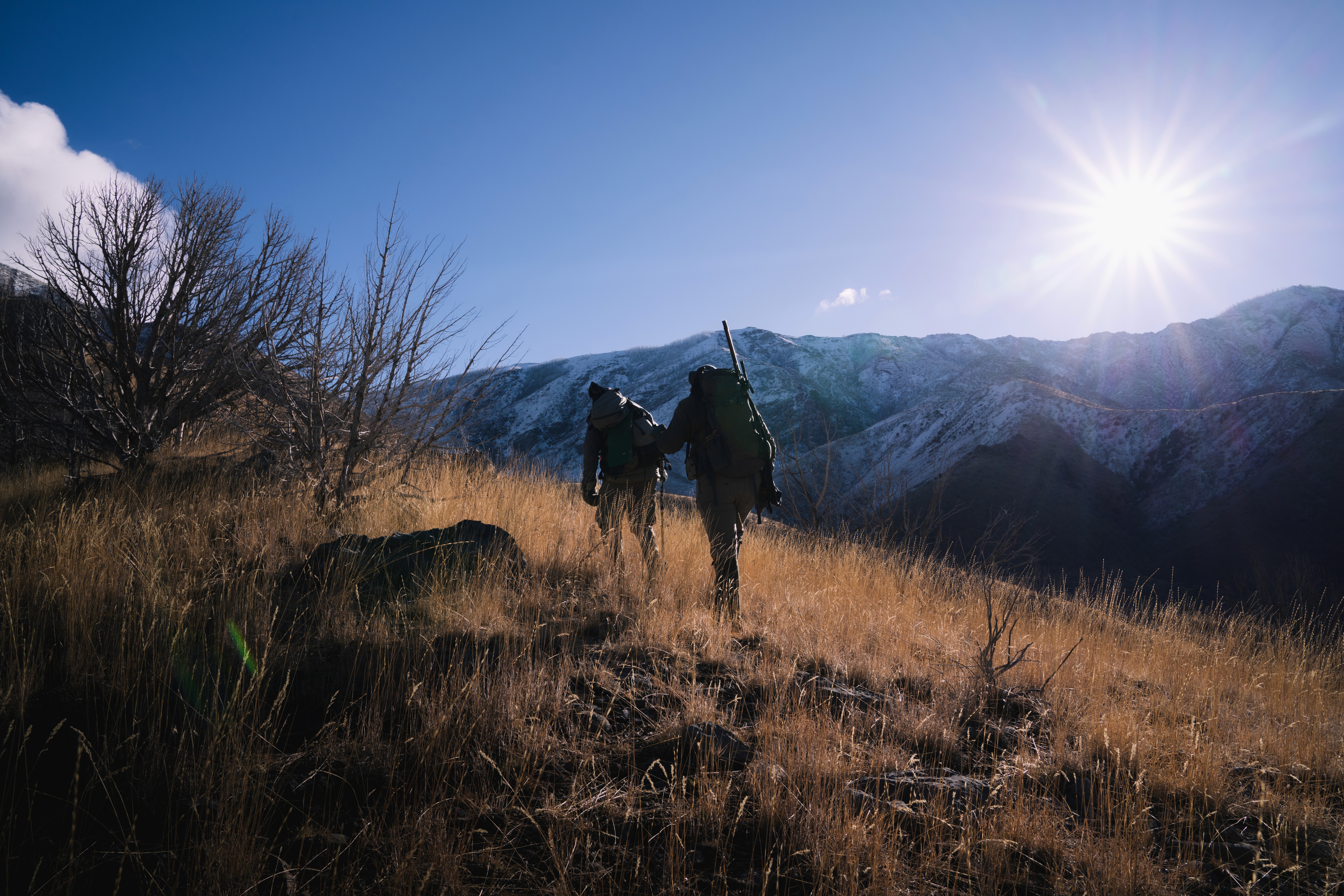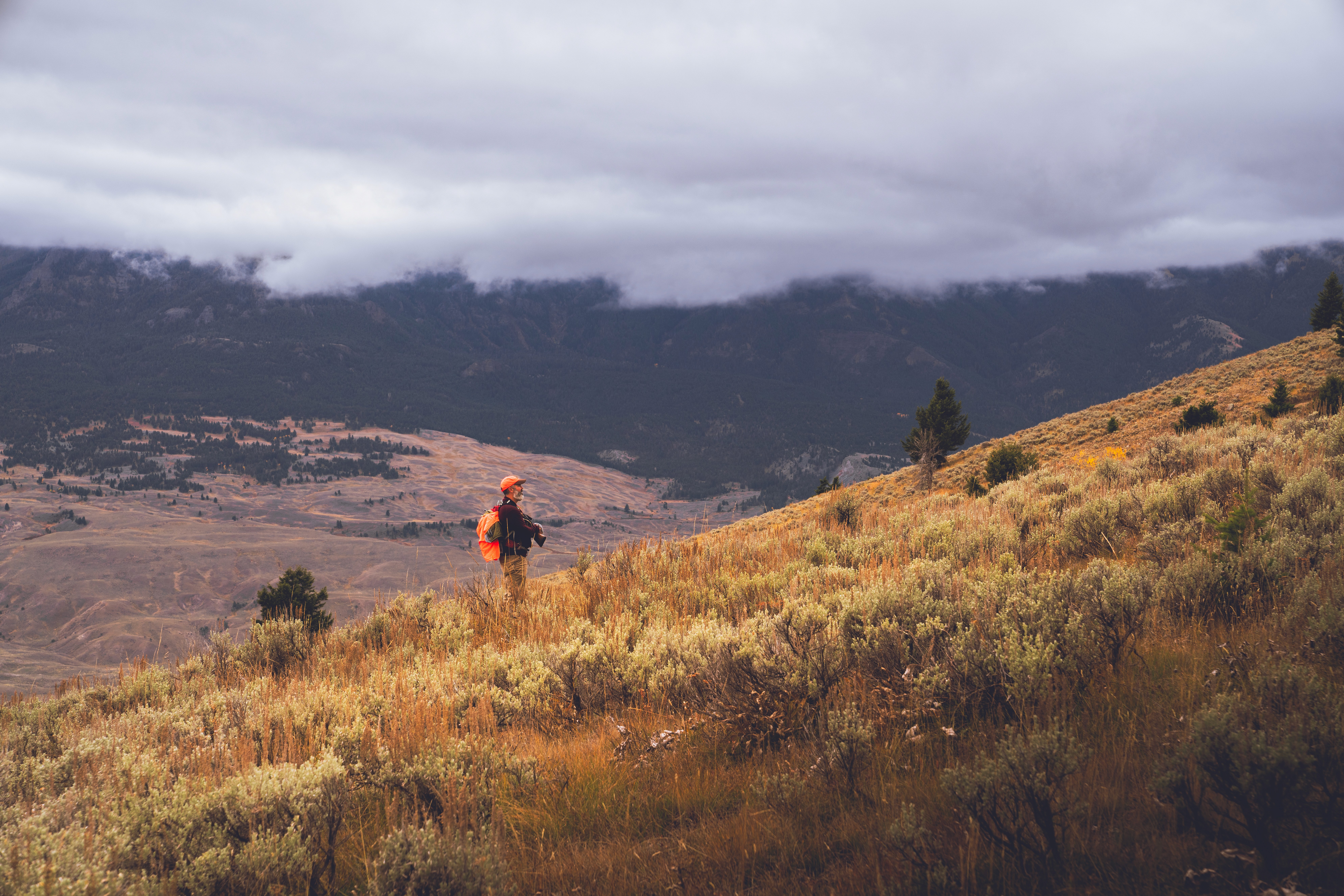



PackMule
Human Predator Packmule Ethos

I have a drive that’s often a compulsion: I must break things down into their foundational elements. What makes the thing, the thing? Is an ever-present question in my mind. Understanding what makes the thing helps us build the thing, to improve the thing. More, it helps us craft a vision for the thing and push it to reach its potential. We can understand the spirit of the thing, how to behave as or with the thing. And with all of that information, we create a culture – an ethos.
The thing we’re breaking down is you, and it’s me. It is the physically and mentally prepared hunter. When I started training for western hunting, I spent a lot of time thinking, writing, and talking about what’s elemental to physical and mental hunting prep. Then, three elements came out one day during a conversation with a hunting buddy:
“You’re Human first. Then you get to be a Predator. If all goes well, you’re a Packmule.”
Human. Predator. Packmule.
They are the symbols and the reality of a hunter with dialed body and calm, focused mind. They are elemental.
Since 2019, we’ve rested our ethos on these elements. HPPM is a community of hunters from across North America. And because we know what makes the thing the thing – we’re Human first, then Predators, then Packmules – we train and prepare with focus on this hunting season. We have our eyes on each hunting season for the rest of our lives.
We want you to join our clan. But first, we want you to understand what it means to be Human, Predator, Packmule.
Human

To be human is to be many things wrapped in one package. We are an amalgam of everything that came before us, from thunder lizards to our common ancestor with chimpanzees. It’s reflected in our brains and our bones; it’s observed in our emotional layers and our biology blending with ecology. Just seeing trees changes our health and wellbeing in the moment.
Being human also makes us unique. There’s no other animal on earth like us. And there’s nothing else in the universe as complex as our brain. We can remember the past; we can plan our futures; we can live in the present. Our psychology gifts us consciousness and unprecedented intelligence. Our physiology makes us the most adaptable creature in the world. We begin by making the most of that physiology.
Endurance is a hallmark of human ability. We’re much slower and much weaker than the rest of nature’s predators. (Hell, most monkeys would whoop our asses.) But we have the potential to keep going long after most predators would need the comfort of the cool ground and a shade tree. Our ancestors lived that endurance, but the modern world necessitates that we develop it. In doing so, we build the Human foundation of HPPM.
Aerobic capacity, aerobic power, movement capacity, strength, power, and movement economy. We focus on these qualities to build the endurance and resilience each hunter needs. Without them, you’ll have a harder time getting to where you need to be, and likely won’t enjoy the journey. Without them, you’re a liability to yourself and to your hunting partners. Rather than confidently approaching each climb and knowing that you have the reserves to make the final push toward any opportunity, you’re left to wonder whether or not you can do it.
But these qualities, and the endurance they promote, can’t be developed without intelligence. It takes planning. And it takes following the plan while listening to the data that tells us to back off when we should and to drop the hammer when we should..
We move well; we develop our aerobic system; we get and stay strong; and we do it all intelligently.
Because that’s what keeps us Human and in the hills.
First, we’re Human.
Predator

(Coach Jordan with his Nevada, muzzleloader mule deer buck.)
I was once asked why I have to hunt.
It was a ZOOM call full of non-hunters. Don’t get the wrong idea, they were all intrigued, not hostile. Well, except for one lady that I’m sure hated my guts. They were curious because I said I loved animals. They wanted to know how, if I loved the animals so much, could I kill them. Couldn’t I just photograph them instead? I didn’t then, and still don’t, feel the need to justify myself as a hunter. But I’m always open to conversation, if it is a real conversation and not a set up for an attack. And I was grateful for the question. It made me think about the Predator element of our ethos.
Watch an efficient predator at work. Pull up a video of a big cat stalking an ungulate. Watch a fox stalking a bunny. They’re totally committed to the hunt. Their vision narrows to their objective. They’re fully immersed in the environment. We’re after the same experience.
The world looks much different when you’re staring through the sights of a gun than through the viewfinder of a camera. The gun, the bow, whatever weapon you wield, makes you an active participant in the environment. You’re no longer an observer of wildlife; you are wildlife. You are the big cat totally committed to the hunt. You are the fox focused on the bunny. You are there and nowhere else. There is no other experience like it. The Human work gets us to the experience.
Whether you’re saddle hunting whitetails or traversing the chukar hills, you can’t be fully present in the moment if you’re sucking wind and focused on how shitty you feel. And you can’t be an efficient predator. Good luck holding your bow at full draw with screaming muscles and burning lungs. Good luck controlling the wobble of your reticle when you can’t get your breathing under control. Every critter for 500 yards will hear your feet fall heavy with each step as you stumble forth on tired legs.
But when you intelligently do the work, you don’t have to worry. You are confident. You may relax and hunt. And when you sit there on top of the ridge, knowing the work got you there, you realize that the Human is necessary for the Predator.
We also deconstruct the experience to extract the values – commitment, focus, presence. Commitment to the training process and skill development. Focus on the outcomes we’re working to achieve. Presence in the moment that allows you to live out the first two values.
There’s one more value – persistence. Wild predators strike out, a lot. But they keep after it. Of course, they have to or they’ll die. But we need that same persistence. There will be setbacks. There will be misses, close calls, frustrations, and losses. There is no progress without persistence.
I believe it’s the stakes that drive persistence. We hunt for enjoyment, but we are enveloped by the stakes of life and death. They are what turn us from observer into wildlife. Without an accurate appraisal of the stakes, there is no drive for growth and development. We need them to reach our potential.
Then, we are Predator.
Packmule

(My hunting buddy, and HPPM client, Christian Snook with his Montana, mule deer buck. That was a long night. He embodied the Packmule that night for sure.)
It’s not right that calling someone a packmule often denotes that they worth nothing more than being a beast of burden. In some cultures, mules symbolize health, happiness, and prosperity. Mules are smart and social. They form strong bonds with people and other animals. And they’re used to protect livestock. Mules will stomp the guts out of a coyote. So, when you think of a Packmule (I know I spell it incorrectly, I do it on purpose.), I want you to think of more than just some critter that hauls stuff – especially when you think about our ethos.
You embody the Packmule by doing the work – physical and mental. Packmules handle the drudgery of putting on foot in front of the other, but they’re also cautious and intelligent. That’s why they haul loads through treacherous terrain. The Packmule is tough and stoic. They accept what is and move forward.
Embodying the Packmule toughens you for doing the Human work, and becoming the Packmule is the outcome of doing the Human work. They simultaneously feed each other. But you don’t become the Packmule without doing the Human work. You must show up intelligently. You must put one foot in front of the other. And you must keep doing both over and over.
Then we're the Packmule.
The HPPM Chimera

I won the Greek Mythology Bee in seventh grade. That’s only one of many dorky things I’ve done. I’ve always loved stories, especially epics that dissolve aspects of human nature into characters. And I had a teacher whose excitement for the ancient Greeks brought out my love for stories. I devoured the tales, reading many of them until I committed them word for word to memory.
The Chimera was a Greek mythological beast. It had the body and head of a lion with a goat’s head protruding from the back. Its tail was a snake. The son of a bitch breathed fire. It gave birth to the Sphinx. When I started playing with the concept of Human Predator Packmule, I kept imagining some kind of Chimera to represent the three parts that comprise and embody our ethos. The concept was there, but it was fuzzy in my mind. So, I took it to a world class designer.
My friend Elias Carlson is the Design Director for Modern Huntsman, as well as a freelance designer and photographer. We went through a rigorous process that explored my ideas and values associated with HPPM. Then I cut him loose to do his magic. I’ll tell you, it is worth hiring a great designer.

(Elias and I on the Alaskan tundra just after he killed a caribou bull.)
Elias captured it, man. The Human element, its power represented in the lightning bolt, holds dominion above the other two elements. Predator and Packmule bodies face each other, showing they’re both integral. Each element, Human, Predator, and Packmule is together but separated to show their connection but that they also stand on their own as necessary.
And it looks cool.
We all get to live out our own epic myth if we approach life with a sense of adventure. We go the unknown, face our trials, overcome the abyss, and return to share what we’ve learned – having a hell of a time all the while. HPPM exists to help hunters live out their personal myth, to approach life with a sense of adventure, to go into the wild feeling confident and capable to take it on because the body and the mind are ready.
The HPPM Chimera is the symbol that reminds us to take on that adventure, to do the work, and keep doing the work, that makes us the person that lives up to our own myth and comes home with tales to tell.
(This blog article marks the official launch of our website.)
Recent posts
Related Articles

Fitness Tips
Dec 21, 2025
Honest Efforts: Don't Mail In Meaningful Work
Despite all of this, I think everyone can agree that training involves effort. Zoom out and look at what humans are physically capable of and it's really amazing what sustained effort in any direction leads to. Ballet dancers, endurance athletes, baseball players, F1 drivers - just a few of the many testaments to sustained effort over time. While most of us aren’t trying to be the next Ohtani or Verstappen, we can take one lesson with us - consistent effort drives outcomes.

Fitness Tips
Dec 21, 2025
Honest Efforts: Don't Mail In Meaningful Work
Despite all of this, I think everyone can agree that training involves effort. Zoom out and look at what humans are physically capable of and it's really amazing what sustained effort in any direction leads to. Ballet dancers, endurance athletes, baseball players, F1 drivers - just a few of the many testaments to sustained effort over time. While most of us aren’t trying to be the next Ohtani or Verstappen, we can take one lesson with us - consistent effort drives outcomes.

Fitness Tips
Dec 21, 2025
Honest Efforts: Don't Mail In Meaningful Work
Despite all of this, I think everyone can agree that training involves effort. Zoom out and look at what humans are physically capable of and it's really amazing what sustained effort in any direction leads to. Ballet dancers, endurance athletes, baseball players, F1 drivers - just a few of the many testaments to sustained effort over time. While most of us aren’t trying to be the next Ohtani or Verstappen, we can take one lesson with us - consistent effort drives outcomes.

Mountain Hunting
Dec 15, 2025
How to Test Your Uphill Muscular Endurance for Mountain Hunting
Mountain hunting is a lot of things. It’s an adventure and for many hunters it’s a rite of passage. It’s a challenge of skill, a test of will, and, oftentimes, an experience that at least borders the spiritual. It is also an endeavor that requires a huge amount of muscular endurance. It’s tough to build your uphill muscular endurance to the right levels without knowing where you currently stand and what kind of training will move the needle for you. So, let’s learn you up on how to test your uphill muscle endurance for mountain hunting.

Mountain Hunting
Dec 15, 2025
How to Test Your Uphill Muscular Endurance for Mountain Hunting
Mountain hunting is a lot of things. It’s an adventure and for many hunters it’s a rite of passage. It’s a challenge of skill, a test of will, and, oftentimes, an experience that at least borders the spiritual. It is also an endeavor that requires a huge amount of muscular endurance. It’s tough to build your uphill muscular endurance to the right levels without knowing where you currently stand and what kind of training will move the needle for you. So, let’s learn you up on how to test your uphill muscle endurance for mountain hunting.

Mountain Hunting
Dec 15, 2025
How to Test Your Uphill Muscular Endurance for Mountain Hunting
Mountain hunting is a lot of things. It’s an adventure and for many hunters it’s a rite of passage. It’s a challenge of skill, a test of will, and, oftentimes, an experience that at least borders the spiritual. It is also an endeavor that requires a huge amount of muscular endurance. It’s tough to build your uphill muscular endurance to the right levels without knowing where you currently stand and what kind of training will move the needle for you. So, let’s learn you up on how to test your uphill muscle endurance for mountain hunting.

Mountain Hunting
Dec 10, 2025
The Toughest Hunt on Earth: Himalayan Blue Sheep Expedition
“It’s truly an expedition. I’d even say it’s the purest hunt on earth.” This wasn’t the first time Trey Sperring and I had talked about hunting blue sheep in Nepal. It wasn’t even the second. The first was during our mutual friend and client, John Mark Prewitt’s, California Big Horn hunt in November 2024. Since then, we’ve texted about it, mentioned it on phone calls, and even discussed it during episode 74 of the Packmule Podcast. It is a conversational thread running through our friendship.

Mountain Hunting
Dec 10, 2025
The Toughest Hunt on Earth: Himalayan Blue Sheep Expedition
“It’s truly an expedition. I’d even say it’s the purest hunt on earth.” This wasn’t the first time Trey Sperring and I had talked about hunting blue sheep in Nepal. It wasn’t even the second. The first was during our mutual friend and client, John Mark Prewitt’s, California Big Horn hunt in November 2024. Since then, we’ve texted about it, mentioned it on phone calls, and even discussed it during episode 74 of the Packmule Podcast. It is a conversational thread running through our friendship.

Mountain Hunting
Dec 10, 2025
The Toughest Hunt on Earth: Himalayan Blue Sheep Expedition
“It’s truly an expedition. I’d even say it’s the purest hunt on earth.” This wasn’t the first time Trey Sperring and I had talked about hunting blue sheep in Nepal. It wasn’t even the second. The first was during our mutual friend and client, John Mark Prewitt’s, California Big Horn hunt in November 2024. Since then, we’ve texted about it, mentioned it on phone calls, and even discussed it during episode 74 of the Packmule Podcast. It is a conversational thread running through our friendship.

Fitness Tips
Dec 21, 2025
Honest Efforts: Don't Mail In Meaningful Work
Despite all of this, I think everyone can agree that training involves effort. Zoom out and look at what humans are physically capable of and it's really amazing what sustained effort in any direction leads to. Ballet dancers, endurance athletes, baseball players, F1 drivers - just a few of the many testaments to sustained effort over time. While most of us aren’t trying to be the next Ohtani or Verstappen, we can take one lesson with us - consistent effort drives outcomes.

Mountain Hunting
Dec 15, 2025
How to Test Your Uphill Muscular Endurance for Mountain Hunting
Mountain hunting is a lot of things. It’s an adventure and for many hunters it’s a rite of passage. It’s a challenge of skill, a test of will, and, oftentimes, an experience that at least borders the spiritual. It is also an endeavor that requires a huge amount of muscular endurance. It’s tough to build your uphill muscular endurance to the right levels without knowing where you currently stand and what kind of training will move the needle for you. So, let’s learn you up on how to test your uphill muscle endurance for mountain hunting.


